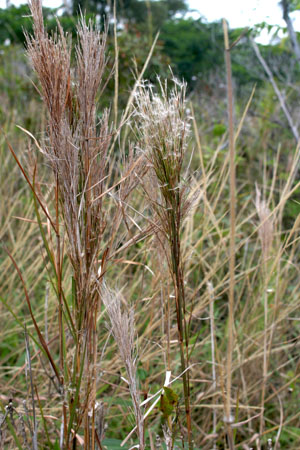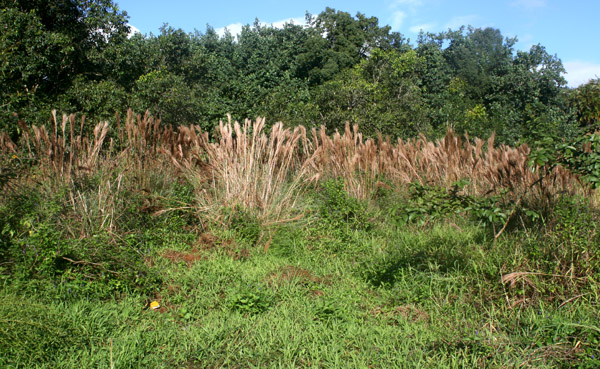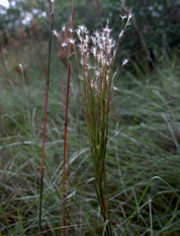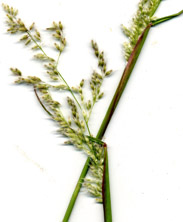| |
Our most common plumose grasses are:
|
|
|
|
[PLUMOSE PANICULATE GRASSES]
|
|
|
|
|
89a
|
(82) |
Inflorescence highly branched from middle and upper culm nodes, overall shape broom-like. Racemes arising in the axils of narrow bracts or spathes
|
|
[90] |
|
89b
|
|
Inflorescence not broom-shaped or weakly so, branching typically off the culm above the leaves; overall shape spindle to ovoid in outline; if somewhat broom-shaped, racemes lax and leaning more or less in unison downwind. Racemes not extending above bracts or spathes
|
|
[91]
|
|
~~~~ ~~~~~~~~~~~~~~~~~~~~~~~~~
|
|
|
90a
|
(89) |
 Racemes paired on a stem. { A medium-size, perennial, clumping grass, forming dense stands in open areas in mesic environments, above 150 ft (50 m), especially on O‘ahu and Hawai‘i (Fig. 15A). HDA noxious weed. Broomsedge, yellow bluestem [HAW - NAT] [FACU]
Racemes paired on a stem. { A medium-size, perennial, clumping grass, forming dense stands in open areas in mesic environments, above 150 ft (50 m), especially on O‘ahu and Hawai‘i (Fig. 15A). HDA noxious weed. Broomsedge, yellow bluestem [HAW - NAT] [FACU]
Figure 15A. Broomsedge grass is characterized by an abundance of silky branches (densely ciliate internodes and pedicels) supporting awned spikelets. These eventuially fall away (inflorescence in foreground, left), the silky quality is lost, leaving a tall, nearly bare, culm.
|
|
|
90b
|
|
Raceme single on a stem branch. { A large, perennial, clumping grass, forming dense stands in open areas in mesic environments on Kaua‘i, O‘ahu, and Hawai‘i (Fig. 15B and 15C). HDA noxious weed. Giant broomsedge, beardgrass [HAW - NAT] [FAC] Andropogon tenuispatheus) (Nash) Nash
[O‘ahu, and Hawai‘i]
Andropogon bicornis L. [Kaua‘i]
|
|
|

Figure 15B. A stand of Andropogon bicornis (giant broomsedge) at Kapahi, Kaua‘i. For scale, yellow notebook at bottom left is 5 inches across.
|
|
~~~~ ~~~~~~~~~~~~~~~~~~~~~~~~~
|
|
|
91a
|
(89) |
Inflorescence a small to large plume: an open-panicle with spikelets bearing numerous white to pink or glossy purple bristles, the overall shape from spindle-shaped to narrowly ovoid in outline. Ligule ciliate (dense rim of tall hairs). Spikelets not narrow
|
|
[92] |
|
91b
|
|
Inflorescense a plume-like panicle with racemes typically all leaning or nodding in same general direction. Ligule a membrane.
Narrow, elongated spikelets grouped in twos, threes, or more on long (some branched) pedicels. Rachis narrow, not winged, evenly three-sided. { Very common, medium-size perennial, clumping grass in dry to mesic, disturbed sites. Sourgrass [HAW - NAT] [FACU]; cotton grass, sour grass [GUM - NAT] Digitaria insularis (L.) Mez ex Ekman
|
|
|
~~~~ ~~~~~~~~~~~~~~~~~~~~~~~~~
|
|
|
92a
|
(91) |
 Bracts enclosing florets (the upper glume and sterile lemma) broad at their base, the basal portion covered with wart-like or bulbous bases of numerous, long silky bristles, these extending well beyond the bracks and redish in color when fresh. Although a small awn may be present, this not easily seen within the bristles. {A small, distinctive, clumping grass: when in flower, the inflorescence is a glossy pink to red color. Widespread, but mostly found in dry, disturbed sites (Fig. 15D). Natal redtop, Natal grass [HAW - NAT] [FACU] [GUM - NAT] [FAC]
Bracts enclosing florets (the upper glume and sterile lemma) broad at their base, the basal portion covered with wart-like or bulbous bases of numerous, long silky bristles, these extending well beyond the bracks and redish in color when fresh. Although a small awn may be present, this not easily seen within the bristles. {A small, distinctive, clumping grass: when in flower, the inflorescence is a glossy pink to red color. Widespread, but mostly found in dry, disturbed sites (Fig. 15D). Natal redtop, Natal grass [HAW - NAT] [FACU] [GUM - NAT] [FAC]Melinus repens (Willd.) Zizka
|
|
|
92b
|
|
Not as above
|
|
[93]
|
|
|
|

|

|
|
|
|
|
Figure 15C. Inflorescence of Andropogon bicornis. (2.9 MB).
|
Figure 15D. Inflorescence of Natal redtop (scan), Melinus repens. (1.3 MB).
|
|
 TABLE of CONTENTS TABLE of CONTENTS
 TO PAGE 14 TO PAGE 14
 HAWAII INTRO HAWAII INTRO
 GUAM INTRO GUAM INTRO
 AECOS, Inc. AECOS, Inc.
|
|